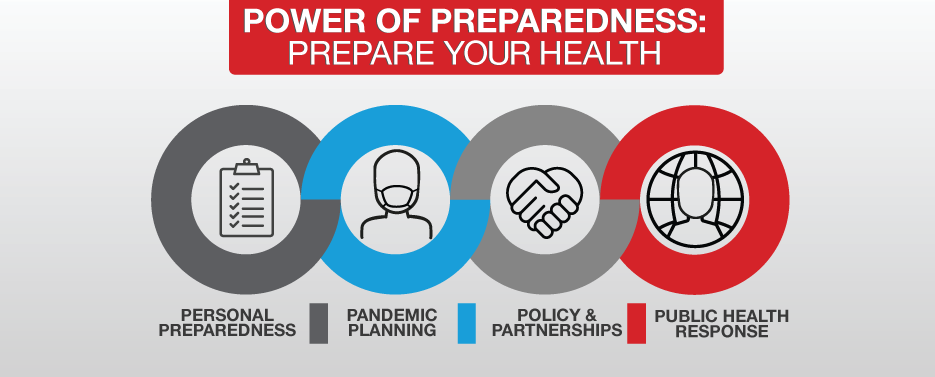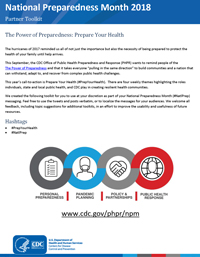Preparedness Month 2018

Partner Toolkit
The Power of Preparedness: Prepare Your Health
Every September, the Centers for Disease Control and Prevention (CDC) along with 3,000 global, national, regional, and local governments, as well as private and public health institutions, supports emergency preparedness efforts and encourages Americans to take action before, during, and after an emergency. Every community in the United States should be ready to respond to an infectious disease outbreak, chemical or radiological release, or natural disaster.
This year CDC’s Office of Public Health Preparedness and Response is highlighting Prepare Your Health. Each week focuses on the roles individuals, state and local public health, and CDC play in creating resilient health communities.
Week 1: Personal Health Preparedness. Every healthy decision you make and preparedness action you take supportscommunity resilience, and improves your family’s ability to respond to a public health emergency. Be prepared with nonperishable food, safe water, basic supplies, and the personal items you’ll need to protect your health until help arrives.
Week 2: Pandemic planning. We remember. We prepare. In the 100 years since the 1918 flu pandemic, CDC has used science, surveillance, and service to improve influenza preparedness. Although pandemics occur infrequently, CDC works year-round with its partners, including state and local public health departments, to detect, prevent, and prepare for the next pandemic.
Week 3: Policy and Partnerships. Every response is local. Planning and preparedness for all types of public health emergencies, including pandemic influenza, is vital to keeping communities safe. States and communities are developing preparedness plans and strengthening their ability to respond. CDC plays a key role in getting states and local jurisdictions prepared for threats to personal and public health.
Week 4: Public Health Response. 15 years of a dedicated EOC. When an emergency happens, CDC must respond quickly and to scale. When response efforts fail, outbreaks become epidemics and natural disasters become settings for illness and injury. CDC’s Emergency Operations Center (EOC) brings together experts and state-of-the-art technology to detect and respond to public health emergencies, like the H1N1 influenza outbreak in 2009.
Keep National Preparedness Month Going All Year
Though National Preparedness Month officially ends in the September, the conversation about emergency health preparedness should not. Here are some ways you can help us keep the topic of personal and public health preparedness on people’s tongues and in their social media timelines year-round:
- Add a monthly blurb about preparedness to your newsletter.
- Save and share our social media graphics.
- Add our syndicated web content into your website.
- Download, print, and share FREE Ready Wrigley activity books and resources.
- Follow @CDCemergency on Twitter, and like us on Facebook.
- Sign up to receive email updates from the CDC Office of Public Health Preparedness and Response.






















.jpg)









No hay comentarios:
Publicar un comentario